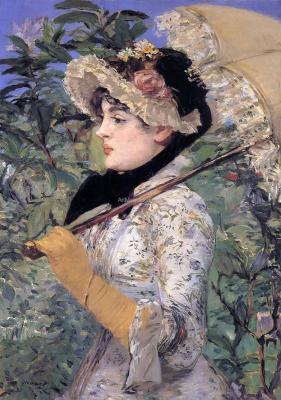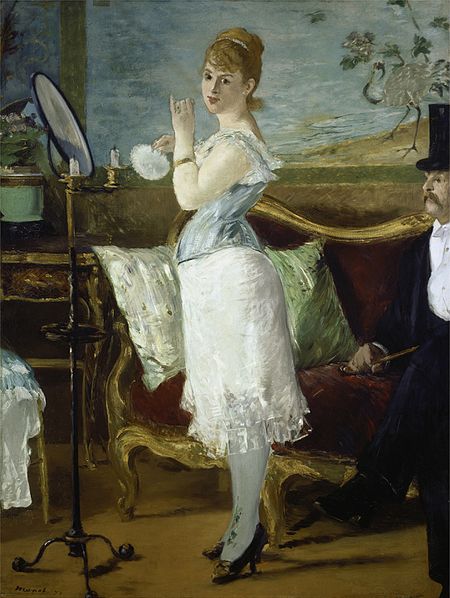The title of an exhibition at Chicago’s Art Institute is both paradoxical and misleading. It is called “Manet and Modern Beauty” and uses a picture of his, “Jeanne (Spring)”, as the cover of its catalogue, and she certainly is quite pretty. The title is paradoxical, nonetheless, because the idea that there is a kind of beauty that is modern is problematic, the association of the two words something of an oxymoron, because people pretty much look the same since the Greeks first sculpted nude men and nude women. So how can there be a modern beauty? Evolution would not make you think the bodies of people would change in twenty five hundred years, much less in less time than that. Nineteenth Century nudes are portraits of the women walking today down Fifth Avenue fully clothed. And the title is misleading because the show includes a lot of Manet’s late paintings of flowers. That is not beautiful in the same sense that women are beautiful. Flowers are, at best, pretty, while the beauty of women has a very deep resonance, their beauty a mystery composed from both lust and the formal arrangement of features. So we want to search out if there is something in Manet that explains the paradox that what women in particular have is eternal and yet situated in the modern age.
One solution to this problem is to treat the exhibit as not really meaning “modern”, with all that implies about the intellectual history of the past few centuries. The exhibit may merely mean that the beauty Manet depicts is French, the women in his paintings having the round faces, the ample cheeks, the narrow eyes, that can be associated with French women, as well as hats and couturie that mark off the French, and that is certainly true of Jeanne. But that would be to trivialize the idea of the exhibit, and yet that is just what the catalogue to the exhibition says to explain it: the exhibition is not an inquiry into the nature of beauty but is interested in documenting the lives of the beautiful in contemporary Paris, what these women, in particular, are like, both in the way they saunter through the streets of Paris and what they look like in various stages of undress when they repair to Paris interiors. And so it is necessary to shift the critics point of view to a consideration of what we can learn about social life rather than about beauty, and such a refocussed inspection does produce results.
Manet, most notably, in his time is among those who introduce the women who model for them as in various states of undress is that is to be contrasted with women either fully clothed or more or less entirely undressed, a swath of cloth or veil providing the necessary modesty, which was the way nudes had been previously depicted. So Manet provides the classic “Luncheon on the Grass”, a nude woman picnicking with dressed men as if to create the awareness that women are always the object of men’s lustful attention, even at a picnic.
Another Manet painting that is emphasized in both the exhibition and the catalogue to it is “Nana”. The model looks out at the artist who is catching her in the immodesty of appearing in her underwear, she also observed by an elderly gentleman in a tophat, which suggests that she is a courtesan and so not at all unused to appearing in a way other women find immodest. She is not wearing a skirt and that reveals her embroidered stockings. Contrary to Andrea Dworkin, the heart of pornography is not the impulse to violence and degredation. Rather, it is the display of immodesty, which means the embarrassment of being caught in a state of undress when one doesn’t want to, as happens with a husband or in a doctor’s office or when going about one’s duties as an actress. Immodesty meant or unintended is exciting. What the Impressionists do is tame the pornographic impulse so that it is acceptable to be viewed in a middle class context, even if sometimes they go far enough, as in Courbet's “The Origin of the World”, which is a closeup of a pubis, so that the picture is still hidden in an alcove at the Musee d’Orsay so as not to shock children or anyone else. The Impressionists tamed the pornographic impulse because, unlike pornographers, they are so adept at their art, knowing just how far to go in revealing women so that the audience is just a bit shocked and titillated, all of it made acceptable by the fact that it is, after all, art, and so allowed its improprieties. It is difficult to recapture the level of immodesty Manet catches except perhaps to turn to Mapplethorpe, whose photos I was a bit embarrassed to look at when they were first publicly displayed, and I remember people speaking in loud voices about the artistic qualities of the photographs so as to provide a justification for looking at them. Mapplethorpe knew just what he was doing, though perhaps the shock there too, as with the Impressionists, has also worn off, art historians having to remind students that Manet’s “Olympia” was shocking at the time, though for reasons that today remain elusive. That she looks at the painter can’t really be the reason, I suggest. It is the nudity itself that is embarrassing
There is another way in which Manet helps beauty take on its modern cast. Historically, both men and women were conceived of as objects of beauty. That was certainly true in ancient times when nude statues depict both men or women. It is true of Renaissance portraiture where manly looking men were elaborately dressed in the fashions of their time just as were female subjects. This goes through the Eighteenth Century where men’s costumes were colorful and very carefully tailored with a variety of fabrics, just as were the gowns that women wore. Then things changed. The Victorians made the dress of both males and females downright unflattering, even if the bustle was supposed to suggest that women were of a different body type than men. Clothes were an armor against invasion rather than a source of attractiveness. The Impressionists created, for their part, an asymmetry. Men remained in something of a standard uniform. They were the ones who wore white tie and tails or tuxedos, identical dress required for every male at a formal occasion, while the women took to wearing distinguishing clothes that made them attractive and that expressed through their fashion sense their distinctive personalities. This has continued to the present day. Men now wear nondescript shirts and pants instead of formal dress, and maybe male fashionistas can consider themselves distinctive in their choice of wardrobes, but the whole point is that the dress of men, even if not formal, is non-descript. It is women who still bloom differently and individually, using fashion to express mood, or whether they want to be dressed up for work or fun or to announce sexual availability. Only women have an ostrich's plumage. Manet’s “In the Conservatory” sets that tone: a man in black standing over a seated woman whose dress is not distinguished but who is wearing a hat and carrying a parasol. The two are in their costumes. More famously, Manet’s “Boating” makes the point of the asymmetry of dress for the sexes more starkly. The woman in the boat wears not that informal a dress when out boating while the man is dressed in sailing gear, which means white pants and a white shirt that looks like an undershirt. He is allowed to wear comfortable dress while she is not. Fashion means that she is better turned out than he is though her clothes show that she is required to be decorous.
There is also a way in which Manet refreshes the eye to see beauty in a new way. Many Impressionists were out to capture what beauty looked like when it was caught unaware, and so very different from the posed portrait style of portraiture that was still practiced by Sargent. Degas was preoccupied with ballet dancers because they are just going about their business and so not self conscious about being observed and so their beauty is caught unawares. Unselfconscious beauty is something Gaugain would have to go to Tahiti to capture.
Manet, and most outrageously, achieves the same result by showing women drinking and serving drinks, which might be thought an unwomanly thing to do or at least one which distracts from their beauty, but these many instances do not do that, but rather humanize the women as well as allowing their beauty to be on display without making a show of it. Most famously, in “The Bar at the Folies Bergere”, Manet shows the girl behind the bar who will not be noticed by her patrons, dressed in an uninteresting way, just letting her naked face hang out there because there is no reason for her not to and because she is barely present at the occasion, this just being a job. Her face, however, deserves to be attended to.
Manet goes further in his portraits of women who are self absorbed while doing their drinking and so also exposing their faces in an unposed way, free of the conventions whereby people always form their faces when they know they are being noticed. What being unnoticed also means is that the women are not at their best and so Manet is able to notice when women are not pretty, just as Sargent was able to show how differently pretty are his posed subjects. Rather, some of the women caught in their cups look played out, which means that the signs of their hard lives show in their faces and in their posture. In “The Cafe-Concert”, there is an elderly gentleman, again in a top hat and black coat, sitting next to a woman in a plain dress and with a face where the eyes are unfocused, the eyebrows overgrown, and a deformed lip, who is accompanying him for reasons we can guess while behind them is a young woman drinking, which may be habitual in bars but will not lead to any good. More striking still is “Plum Brandy”. The girl in the picture is alone, leaning on the back of her hand with a cigarette in her other hand. The pink of her dress is attractive as is the color of her face, but she has seen better days. She looks distracted and as sif her eyes have seen too much. Definitely a moral lesson if that was what Impressionist painters were up to, which they are not, but instead want to tell the viewer what life really looks like, a reality from which one might be distracted by the pretty colors.




